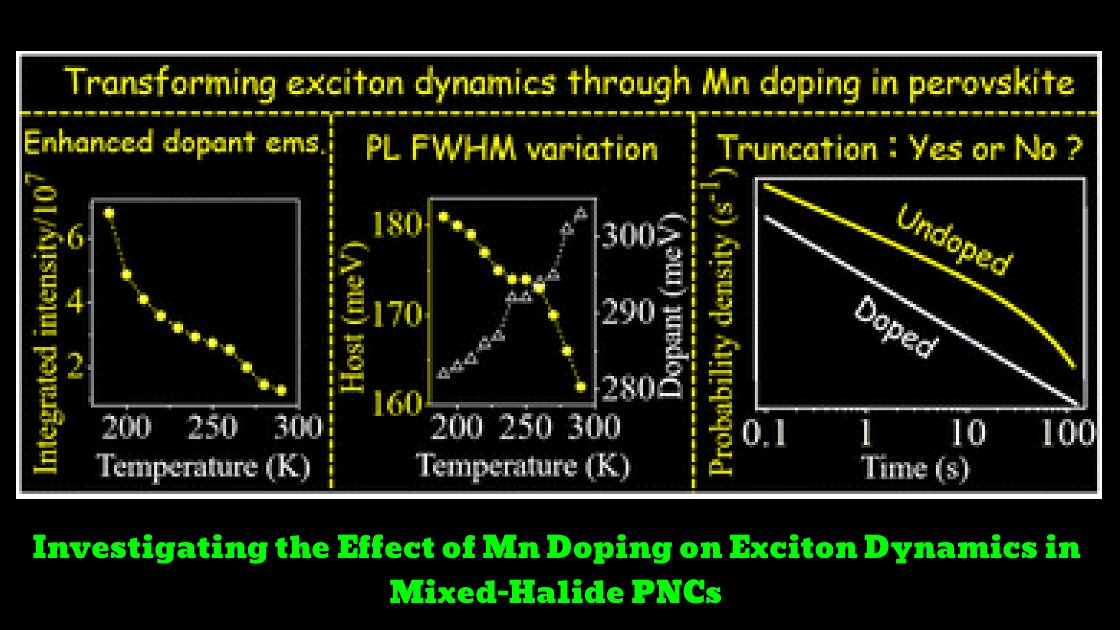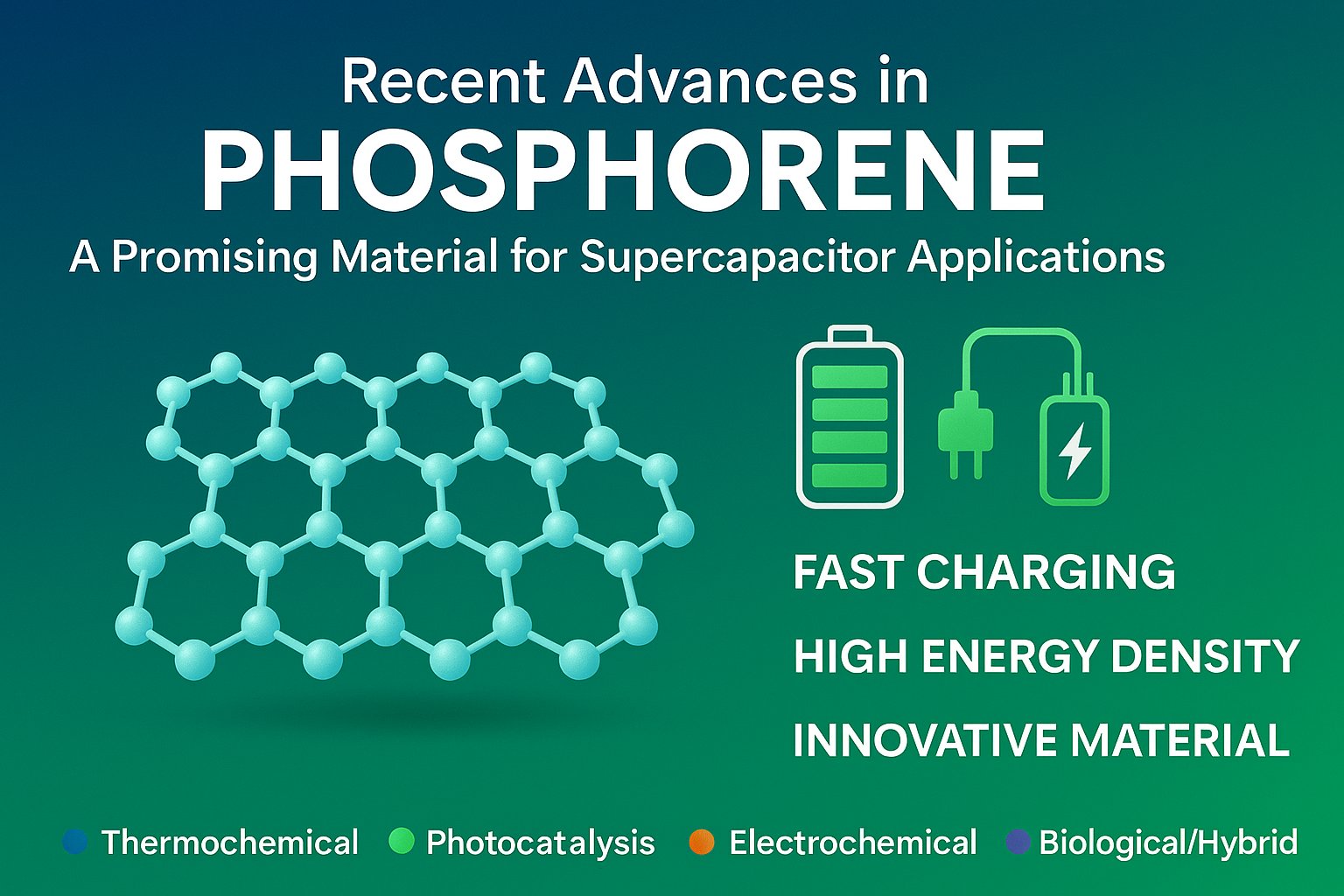Perovskite nanocrystals (PNCs) have the potential to revolutionize optoelectronics due to their superior optoelectronic properties. Researchers have investigated the effect of manganese (Mn) doping on the exciton dynamics of mixed-halide PNCs. The study was conducted on Zn-alloyed Mn-doped CsPb(Cl/Br)3 PNCs with a higher bandgap than the CsPbBr3 PNC system. The study found that Mn doping reduces the host band’s photoluminescence quantum yield (PLQY) value from 58% to 8%.
Details of the Study
- Mn doping does not cause a significant non-radiative pathway for the host band in the PNC.
- The PL intensity of the dopant emission increased by 5.5-fold as the temperature decreased from 290 K to 190 K, unlike literature reports.
- The FWHM (Full Width at Half Maximum) of the host PL emission band increases with a decrease in temperature from 290 K to 190 K for PNC2.
- The temperature-dependent dopant PL decay exhibited biexponential decay behavior with time constants τ1 = 450-540 μs and τ2 = 1.1-1.2 ms.
- The magnitudes of the Huang–Rhys factor and phonon energy were calculated to be 4 ± 0.5 and 58 ± 2 meV, respectively, based on the temperature-dependent variation in the FWHM of dopant PL emission.
- The low value of the Huang–Rhys factor indicates less electron-phonon coupling for the Zn-alloyed Mn-doped CsPb(Cl/Br)3 PNC system.
The study has shown that Mn doping reduces the radiative decay rate associated with the host band of PNCs and increases the non-radiative decay rate. The results indicate that a mixed-halide PNC system would be an interesting choice of perovskite material for investigating the effect of Mn doping on the exciton dynamics of the PNC. This study provides insight into the fundamental physics of Mn doping in mixed-halide PNCs and can help optimize the design of perovskite-based optoelectronic devices.
Transforming exciton dynamics in perovskite nanocrystals through Mn doping
Li; Nanoscale; Mukherjee; Ghosh; Biswas; Ghosal; De; Mandal
Full-text link: https://doi.org/10.1039/d3nr00241a
What this paper is about
- Mn doping in a mixed-halide PNC has not been explored in detail. This mixed-halide system has a higher bandgap than the CsPbBr 3 PNC system.
- Therefore, a mixed-halide PNC system would be an interesting choice of perovskite material to investigate the effect of Mn doping on the exciton dynamics of the PNC.
- Zn-alloyed Mn-doped CsPb PNCs were chosen so that the band-edge PL emission is significantly higher in energy than the dopant PL emission maximum.
What you can learn
- Researchers have observed that because of Mn doping, the PLQY value of the host band decreases from 58% to 8.
- In the literature, it has been reported that the intensity of the host band remains nearly constant with a decrease in temperature from 290 K to 190 K for both undoped and Mn-doped PNCs.
- In the literature, the FWHM values of both host and dopant PL emission have been shown to decrease as the temperature is decreased from 290 K to 190 K. Thermal band narrowing with decreasing temperature is the usual observation, but the FWHM of host PL emission in PNC2 increases as the temperature is decreased, which is quite unusual.
- Unlike literature reports, in which dopant emission has been shown to decrease to zero, in the present case, we report a 5.5-fold enhancement in the integrated PL intensity of dopant emission when the temperature is decreased from 290 K to 190 K. Quite interestingly, the FWHM of the host PL emission band increases with a decrease in temperature from 290 K to 190 K for PNC2, perhaps hinting towards emission from a new state when the temperature is lowered.
- Temperature-dependent dopant PL decay exhibited biexponential decay behavior with the time constants 1 = 450-540 s and 2 = 1.1-1.2 ms. As the temperature decreases from 290 K to 190 K: the amplitude of the faster time component decreases from 80% to 60%, the amplitude of the slower time component increases from 20% to 40%, and the average excited state lifetime increases from 700 s to 950 s. Ultrasensitive single-particle spectroscopic analyses revealed that although the PDDs of the durations of both ON and OFF events of PNC1 could be fitted with TIPL, for PNC2, both PDDs could be fitted with IPL.
- The lower value of the power law exponent m ON for PNC1 compared to PNC2 indicates the higher probability of longer ON events for PNC1 than for PNC2.
Core Q&A related to this research.
- How does Mn doping affect the radiative decay rate of perovskite nanocrystals (PNCs)?
- The study has shown that Mn doping reduces the radiative decay rate associated with the host band of PNCs.
- Does Mn doping have any effect on the non-radiative decay rate of PNCs?
- Yes, the study has found that Mn doping increases the non-radiative decay rate of PNCs.
- What is the suggested choice of perovskite material for investigating the effect of Mn doping on the exciton dynamics of PNCs?
- The results indicate that a mixed-halide PNC system would be an interesting choice of the perovskite material.
- How can the study help optimize the design of perovskite-based optoelectronic devices?
- The study provides insight into the fundamental physics of Mn doping in mixed-halide PNCs, which can help optimize the design of perovskite-based optoelectronic devices.
Basic Q&A related to this research.
What is Mn doping?
Mn doping refers to the intentional introduction of manganese (Mn) ions into a material, in this case, a mixed-halide perovskite nanocrystal (PNC).
What is the radiative decay rate?
The radiative decay rate is when a material emits light as it returns to its ground state from an excited state. In the study context, Mn doping reduced the radiative decay rate of the host band of PNCs.
What is the non-radiative decay rate?
The non-radiative decay rate is when a material returns to its ground state from an excited state without emitting light. The study found that Mn doping increased the non-radiative decay rate of PNCs.
What is a mixed-halide PNC system?
A mixed-halide PNC system is a type of perovskite material composed of a mixture of halide ions. In the study, the researchers suggest that this type of material may be an interesting choice for investigating the effects of Mn doping on exciton dynamics.
What is perovskite material?
Perovskite material is a crystal structure with a particular arrangement of atoms. It has gained attention in recent years due to its potential use in solar cells and other optoelectronic devices.
What is exciton dynamics?
Exciton dynamics refers to the behavior of excitons, which are pairs of negatively charged electrons and positively charged holes that are formed when a material absorbs light. The study aimed to investigate the effects of Mn doping on exciton dynamics in mixed-halide PNCs.
What is fundamental physics?
Fundamental physics refers to the study of the basic laws and principles that govern the behavior of matter and energy in the universe. The study of Mn doping in mixed-halide PNCs provides insight into the fundamental physics of this material system.
What are optoelectronic devices?
Optoelectronic devices are electronic devices that use light to perform a function. Examples include solar cells, light-emitting diodes (LEDs), and photodetectors. The study of Mn doping in mixed-halide PNCs can help optimize the design of perovskite-based optoelectronic devices.




